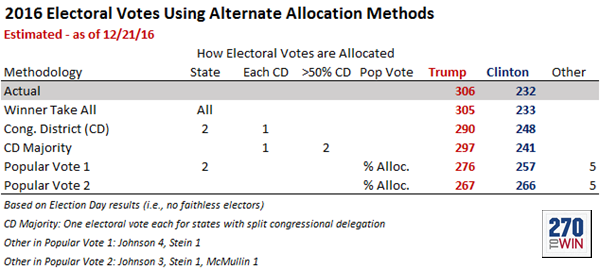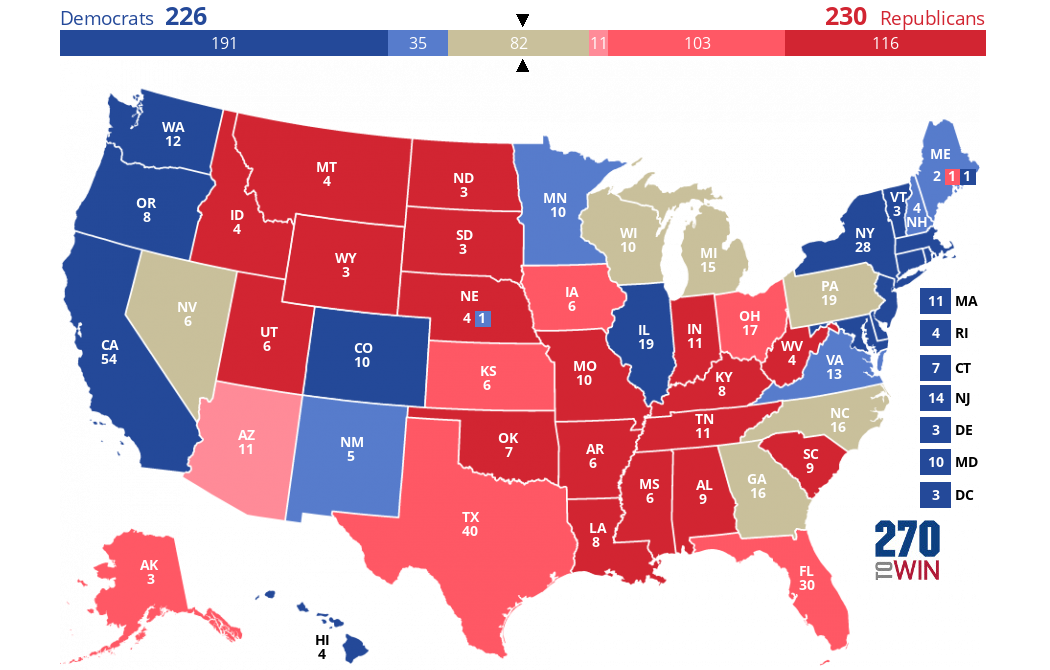2016 Alternate Electoral Methods: A Preliminary Look
By 270toWin Staff
December 22, 2016
One of the more popular questions we get asked is how the election would have turned out using some other allocation methodology. We analyzed this for the 2012 election, and plan to update that for 2016 once all the data is finalized. Look for that over the next month or so.
Enough information is now available to make a pretty good estimate how things would have turned out with each alternative approach*. The bottom line is that in most cases, Donald Trump would still have surpassed 270 electoral votes, but his winning margin would be less than the 74 (306-232, ignoring faithless) electoral votes by which he actually won. However, the impact of these alternate methods is insignificant compared to 2012.

All electoral votes discussed below (and in the table above) are based on Election Day results. Faithless electors are assumed to have voted as pledged.
Winner Take All: Only Maine and Nebraska use a method other than winner take all. This year, Trump won an electoral vote in Maine, which he would not have won if Maine used winner take all.
Congressional District (CD): This is the method currently used by Maine & Nebraska, where two electoral votes go to the popular vote winner of the state, with one awarded to the popular vote winner in each congressional district. In 2012, Romney would have gained 68 electoral votes from the 206 he won, putting him in the White House with 274. This year, Trump would have lost 16, giving him 290. Trump won a number of states that Romney lost, such as Pennsylvania and Ohio, with a large portion of conservative districts. As a result, in these states, the congressional district method would be less beneficial to Trump than winner take all.
CD Majority: This method awards two electoral votes to the winner of the majority of CD in the state, with one awarded to the popular vote winner in each CD. This method will only yield different results than the other CD method when the state popular vote winner doesn't also win the majority of districts. That was infrequent in the 2016 election. Clinton won two states (Minnesota, Virginia), where Trump won a majority of the districts. She also won three states, where the two split the districts. As a result, Trump did 7 better (297 to 290) with this variant of the CD method.
Popular Vote 1 & 2: These two methods allocate electoral votes based on state-by-state popular vote. With Popular Vote 1, two electoral votes go to the winner of the state, with the remainder allocated based on the percentage of popular vote. Popular Vote 2 allocates all the electoral votes based on popular vote percentage. Since Clinton won the popular vote nationally, we would expect these results to be close, and indeed they are. Trump still wins with Popular Vote 1 because he won many more states (30) than Clinton (20+DC). That fact still benefits him - although less so - in Popular Vote 2 because the allocation is done state-by-state. Due to the relative success of third party candidates in 2016, neither Trump nor Clinton would have achieved 270 electoral votes with Popular Vote 2 methodology, throwing the election to the House of Representatives.
*Keep in mind that campaigns make strategic and resource decisions based on the rules in place. If the rules were different, the strategy would be different. That in mind, there's no way to know for sure how the 2016 election would have turned out if another methodology had been in place.

